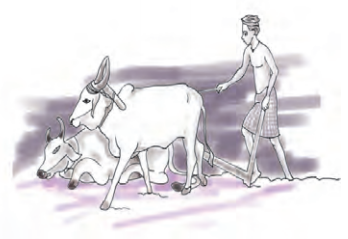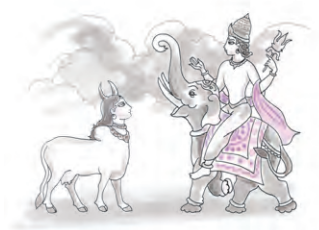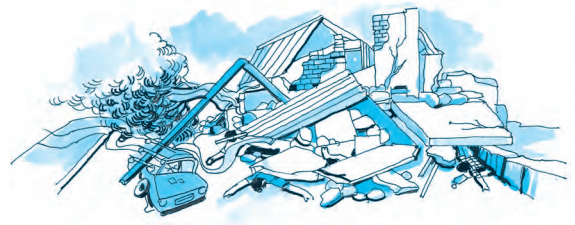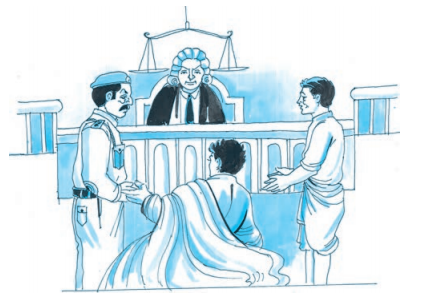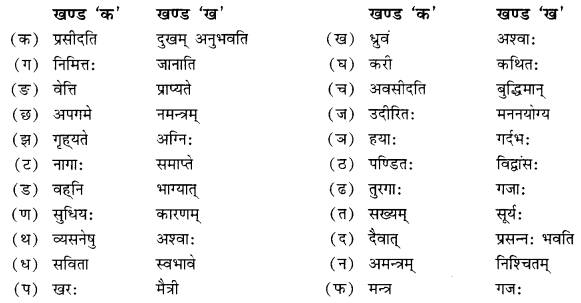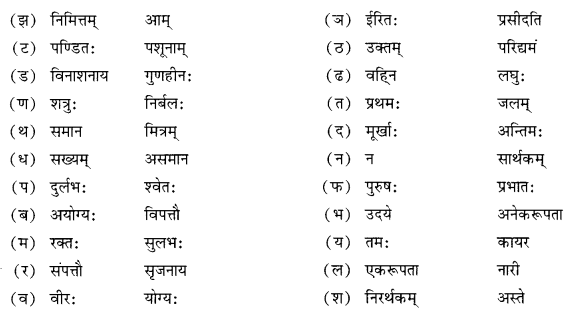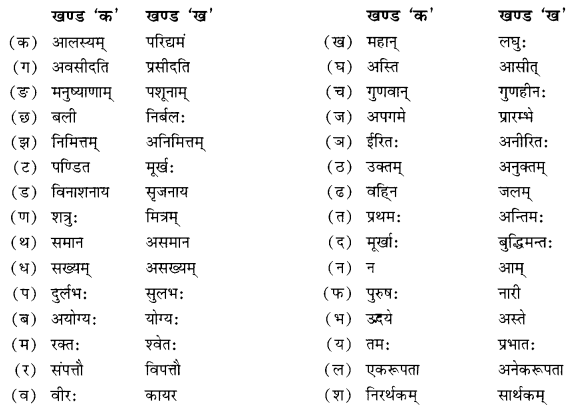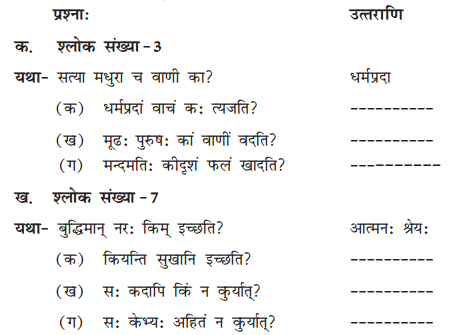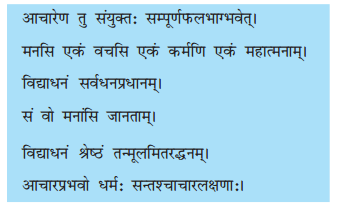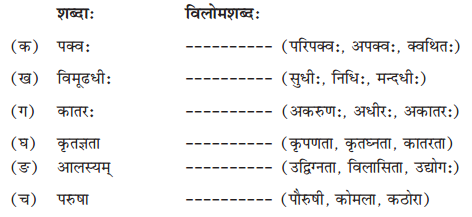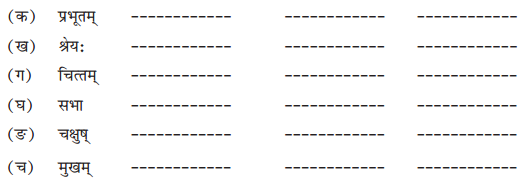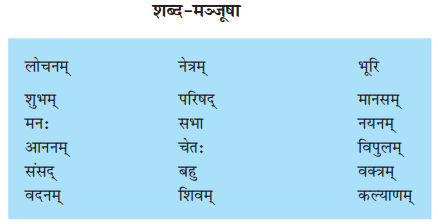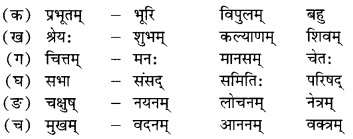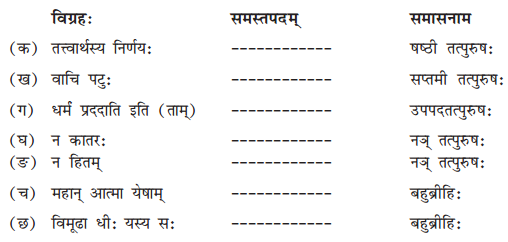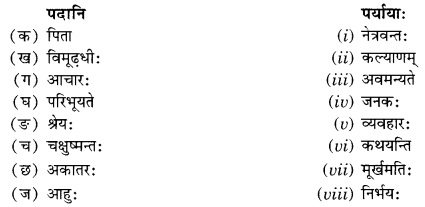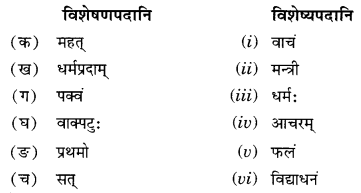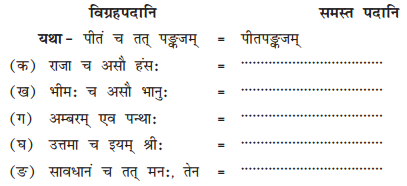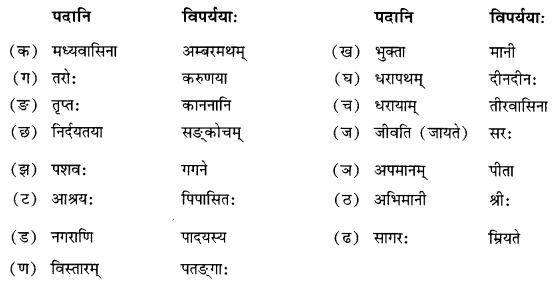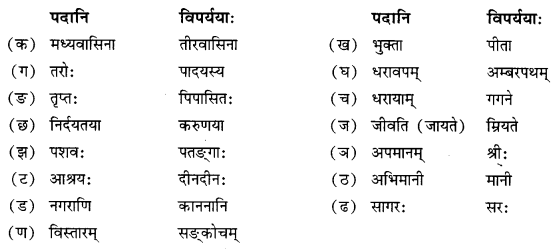We have given detailed NCERT Solutions for Class 10 Sanskrit Grammar Book अव्ययाः Questions and Answers come in handy for quickly completing your homework.
Sanskrit Vyakaran Class 10 Solutions अव्ययाः
अभ्यास:
प्रश्न 1.
समुचितैः अव्ययैः (मञ्जूषातः गृहीत्वा) रिक्तस्थानानि पूरयत-
(i) सः ___________ वनं गतवान्।
(ii) सः ___________ गच्छति?
(iii) गजः ___________ चलति।
(iv) सः ___________ स्वपिति।
(v) सिंहः ___________ गर्जति।
(vi) सः ___________ विजेष्यते।
(vii) परिश्रमं कुरु, ___________ अनुत्तीर्णः भविष्यसि।
(viii) गृहात् ___________ मा गच्छ।
(ix) सः ___________ माम् उद्वेजयति।
(x) कोलाहलं ___________ कुरु।
मञ्जूषा- मा, बहिः, मुहुर्मुहुः, अन्यथा, एकदा, शनैः-शनैः, चिरम्, नूनम्, उच्चैः, कुत्र
उत्तराणि:
(i) एकदा
(ii) कुत्र
(iii) शनैः-शनैः
(iv) चिरम्
(v) उच्चैः
(vi) नूनम्
(vii) अन्यथा
(viii) बहिः
(ix) मुहुर्मुहुः
(x) मा
प्रश्न 2.
अधोलिखितेषु वाक्येषु अव्ययपदं चित्वा लिखत-
(i) यावत् परीक्षाकालः नायाति तावत् परिश्रमं कुरु।
(ii) अस्माभिः सर्वदा सत्यं वक्तव्यम्।
(iii) कालः वृथा न यापनीयः।
(iv) अहं सम्प्रति गृहं गन्तुम् इच्छामि।
(v) त्वं कुतः समायात्?
(vi) अहं श्वः ग्रामं गमिष्यामि।
(vii) तौ परस्परम् आलपतः।
(viii) अद्यप्रभृति अहं धूमपानं न करिष्यामि।
(ix) धनं विना जीवनं वृथा भवति।
(x) अथ रामायणकथा आरभ्यते।
उत्तराणि:
(i) यावत्, तावत्
(ii) सर्वदा
(iii) वृथा
(iv) सम्प्रति
(v) कुतः
(vi) श्वः
(vii) परस्परम्
(viii) अद्यप्रभृति
(ix) वृथा
(x) अथ
प्रश्न 3.
कोष्ठकेभ्यः शुद्धम् अव्ययपदं चित्वा रिक्तस्थानं पूरयत्-
(i) अहम् ___________ भ्रमणाय गमिष्यामि। (श्वः / ह्यः)
(ii) त्वम् कस्य ___________ गच्छसि? (परित: / पुरतः)
(iii) विद्यालयम् ___________ उद्यानम् अस्ति। (परित: / एव)
(iv) सः यदा आगमिष्यति ___________ अहं गमिष्यामि। (तदैव / तथैव)
(v) परिश्रमं कुरु ___________ अनुत्तीर्णः भविष्यसि। (सर्वदा / अन्यथा)
(vi) त्वं ___________ कुत्र गच्छसि? (जातु / साम्प्रतम्)
(vii) यूयम् ___________ ध्यानेन पठत। (बाढम् / नूनम्)
(viii) श्यामः ___________ पठति श्यामा न। (एव / विना)
(ix) छात्राः पुस्तकम् ___________ न शोभन्ते। (यदि / विना)
(x) यथा वप्स्यसि ___________ फलं प्राप्स्यसि। (तदा / तथा)
उत्तराणि:
(i) श्वः
(ii) पुरतः
(iii) परितः
(iv) तदैव
(v) अन्यथा
(vi) साम्प्रतम्
(vii) नूनम्
(viii) एव
(ix) विना
(x) तथा
अभ्यासः
प्रश्न 1.
इमं संवादम् उचितैः अव्ययपदैः पूरयत। उत्तराणि समक्षं प्रदत्तस्थाने लिखत अधा प्रदत्ता (अव्ययानां सूची अधः प्रदत्ता)-
मञ्जूषा – अधुना, अपि, बहिः, नूनम्, उच्चैः
रमा – विश्रुत! मेघाः (i) ___________ गर्जन्ति।
विश्रुतः – आम् (ii) ___________ वृष्टिः भविष्यति।
रमा – अवश्यम्, त्वम् गृहात् (iii) ___________ मा गच्छ।
विश्रुतः – तर्हि अहम् (iv) ___________ दूरदर्शने एव नाटकम् पश्यामि।
रमा – विश्रुत! समाचारम् अपि शृणु, दशमकक्षायाः परीक्षापरिणामस्य सूचना (v) ___________ संभवेत्!
उत्तराणि:
(i) उच्चैः
(ii) नूनम्
(iii) बहिः
(iv) अधुना
(v) अपि।
प्रश्न 2.
अधोलिखिते संवादे उचित-अव्ययपदैः रिक्तस्थानानि पूरयत। (अव्ययानां सूची अधः प्रदत्ता)-
मञ्जूषा – उच्चैः, किमर्थम्, एव, बहिः, अपि
पिता – पुत्र! एषः कोलाहल: (i) ___________ भवति?
पुत्र – (ii) ___________ एका नटी स्वनृत्यकौशलं प्रदर्शयति।
पिता – किम् कश्चित् गायति, वादयति (iii) ___________?
पुत्र – आम्, नटः (iv) ___________ गायति, ढोलकं वादयति च।
पिता – अभ्यासेन (v) ___________ कौशलं प्राप्यते।
उत्तराणि:
(i) किमर्थम्
(ii) बहिः
(iii) अपि
(iv) उच्चैः
(v) एव।
प्रश्न 3.
अधोलिखितम् अनुच्छेदम् उचितैः अव्ययपदैः पूरयित्वा पुनः लिखत-
मञ्जूषा – यदा, तदा, नूनम् एव, अद्य, अपि, यत्र, तत्र, सर्वदा
(i) विद्यालये ___________ वनमहोत्सवः मान्यते।
(ii) छात्रैः गृहेभ्यः ___________ एकः पादपः आनीतः।
(iii) छात्रैः आनीतेषु पादपेषु फलिनः वृक्षाः ___________ सन्ति।
(iv) ___________ वृक्षाः सन्ति ___________ हरीतिमा वर्तते।
(v) ___________ वृक्षेषु फलानि आगमिष्यन्ति ___________ केचन अन्ये एव छात्राः तानि उपभोक्ष्यन्ति।
उत्तराणि:
(i) अद्य
(ii) नूनम् एव
(iii) अपि
(iv) यत्र, तत्र
(v) यदा, कदा।
प्रश्न 4.
अधोलिखितानि वाक्यानि मञ्जूषायाः सहायतया उचितैः अव्ययपदैः पूरयित्वा पुनः लिखत-
मञ्जूषा – यावत्-तावत्, शनैः शनैः, श्वः, विना, मा, उच्चैः, एव
(i) ___________ मम मातुल: काश्मीरात् आगमिष्यति।
(ii) असत्यं ___________ वद।
(iii) ___________ स्थास्यन्ति गिरयः ___________ रामायणी कथा प्रचरिष्यति।
(iv) कच्छपः ___________ चलति।
(v) अस्माकं जीवनं जलं ___________ असम्भवम्।
उत्तराणि:
(i) श्वः
(ii) मा
(ii) यावत्-तावत्
(iv) शनैः शनैः
(v) विना।
प्रश्न 5.
अधोलिखितानि वाक्यानि मञ्जूषायाः सहायतया उचितैः अव्ययपदैः पूरयित्वा पुनः लिखत-
मञ्जूषा – इतस्ततः, सर्वत्र, यथा, तथा, वृथा, उपरि, अधः, कुत्र
(i) वृक्षाणाम् ___________ वानराः कूर्दन्ति।
(ii) ईश्वरः ___________ व्यापकः अस्ति।
(iii) ___________ अश्वाः दग्धाः।
(iv) ___________ च पञ्त्वं गताः।
(v) समुद्रेषु वृष्टिः ___________।
उत्तराणि:
(i) उपरि, इतस्ततः
(ii) सर्वत्र
(iii) यथा
(iv) तथा
(v) वृथा।
प्रश्न 6.
उचितैः अव्ययपदैः इमे संवादाः पूरयन्ताम् (अव्ययानां सूची मञ्जूषायां दत्ता)-
मञ्जूषा – शनैः शनैः, अपि, शीघ्रम्-शीघ्रम्, एव, नूनम्।
विभः – एतत् उपवनम्। यस्य हस्ते करण्डक: (i) ___________ एषः मालाकारः।
रश्मिः – आम्! अहं तं जानामि। एषः मालाकारः (ii) ___________ अस्ति।
विभः – पश्य, उपवने जनाः (iii) ___________ चलन्ति।
रश्मिः – परम् अहं पश्यामि यद् वृद्धाः तु (iv) ___________ चलन्ति।
विभः – पश्य, तत्र महिलाः (v) ___________ भ्रमन्ति।
उत्तराणि:
(i) नूनम्
(ii) एव
(iii) शीघ्रम्-शीघ्रम्
(iv) शनैः शनैः
(v) अपि।
प्रश्न 7.
अयं संवादः उचितैः अव्ययपदैः पूरणीयः। अव्ययपदानि मञ्जूषायाः ग्रहीतव्यानि।
मञ्जूषा – श्वः, तत्र, अत्र, इतस्ततः, अपि
अर्णवः – (i) ___________ एकं विशालम् उपवनम् अस्ति।
प्रत्यूषः – तत्र वृक्षेषु वानराः (ii) ___________ कूर्दन्ति।
अर्णवः – पश्य, (iii) ___________ मयूराः अपि नृत्यन्ति।
प्रत्यूषः – शृणु, वृक्षशाखासु कोकिलाः (iv) ___________ मधुरं गायन्ति।
अर्णवः – आगच्छ, अधुना गृहं गच्छाव। (v) ___________ पुनः आगमिष्यावः।
उत्तराणि:
(i) अत्र
(ii) इतस्ततः
(iii) तत्र
(iv) अपि
(v) श्वः।
प्रश्न 8.
अयं संवादः उचितैः अव्ययपदैः पूरणीयः। अव्ययपदानि मञ्जूषायाः ग्रहीतव्यानि।
मञ्जूषा – विना, सह, नूनम्, यदा, अधुना
मोहनः – राम! त्वं गृहात् बहिः गच्छ।
रामः – अहं त्वां (i) ___________ न गमिष्यामि।
मोहनः – किमर्थम् मया एव (ii) ___________ गमिष्यसि?
रामः – (iii) ___________ रात्रिः अस्ति। अहम् अन्धकारात् त्रस्यामि।
मोहनः – अहं तु न त्रस्यामि। (iv) ___________ त्वया सह गमिष्यामि।
रामः – (v) ___________ मेघाः गर्जन्ति तदा मयूराः नृत्यन्ति।
उत्तराणि:
(i) विना
(ii) सह
(iii) अधुना
(iv) नूनम्
(v) यदा।
प्रश्न 9.
अयं संवादः उचितैः अव्ययपदैः पूरणीयः। अव्ययपदानि अधोदत्तायाः मञ्जूषायाः ग्रहीतव्यानि।
मञ्जूषा – एव, अलम्, उच्चैः, अधुना, शनैः
अध्यापकः – अनिल! अत्र आगच्छ।
अनिलः – आगतः अस्मि, श्रीमन्तः! (i) ___________ किं करवाणि?
अध्यापकः – (ii) ___________ भ्रमणेन। अत्र उपविश।
अनिलः – आम्, उपविशामि। यद् भवन्तः कथयिष्यन्ति तद् (iii) ___________ करिष्यामि।
अध्यापकः – एतं पाठम् (iv) ___________ पठ। पाठम् (v) ___________ न पठ शीघ्रं न पठ।
उत्तराणि:
(i) अधुना
(ii) अलम्
(iii) एव
(iv) उच्चैः
(v) शनैः।
प्रश्न 10.
मञ्जूषायां दत्तानि पदानि संयोज्य वाक्यानि रचयत-

(i) _______________________
(ii) _______________________
(iii) _______________________
(iv) _______________________
(v) _______________________
उत्तराणि:
(i) अहम् ह्यः देवालयम् अगच्छम्।
(ii) अहम् श्वः तरणताले तरिष्यामि।
(iii) अहम् अधुना भोजनम् खादामि।
(iv) अहम् यदा-कदा उपवने भ्रमामि।
(v) अहम् पठितुं विद्यालयम् गच्छामि।
प्रश्न 11.
अधोलिखिते अनुच्छेदे रिक्तस्थानानि उचित-अव्ययपदैः पूरयत। (अव्ययानाम् सूची अधः प्रदत्ता)-
मञ्जूषा – पुरा, एकदा, तत्र, च, एव
(i) ___________ श्रीकृष्णः सुदामा (ii) ___________ शैशवात् मित्रे आस्ताम्। तौ बाल्ये गुरोः संदीपनस्य आश्रमे (iii) ___________ अवसताम्। (iv) ___________ गुरुपत्न्याः आदेशेन तौ काष्ठानि आनेतुं वनं गतौ। वने काष्ठानां कृन्तनकार्ये तयोः सूर्यास्तः अभवत्। तौ हिंसकप्राणिभ्यः भीतौ एकं वृक्षम् आरुह्य (v) ___________ स्थितौ।
उत्तराणि:
(i) पुरा
(ii) च
(iii) एव
(iv) एकदा
(v) तत्र।
प्रश्न 12.
इमां कथां उचितैः अव्ययपदैः पूरयत। अव्ययानां सूची अधः प्रदत्ता।
मञ्जूषा – यदि, एव, सहसा, तु, अधः
आम्रवृक्षस्य (i) ___________ उपविष्टः एकः नरः कोमलासु लतासु विशालफलानि दृष्ट्वा अकथयत्, “मूर्खः ईश्वरः लतासु विशालानि फलानि रोपयति, विशाले वृक्षे तु लघूनि फलानि। (ii) ___________ पवनस्य वेगेन एकं आम्रफलं तस्य शिरसि अपतत्। सः अचिन्तयत् (iii) ___________ वृक्षे विशालफलम् स्यात् तर्हि मम शिरः तु भग्नम् (iv) ___________ भवेत्। ननु अहमेव मूर्खः, ईश्वरः (v) ___________ बुद्धिमान् अस्ति।
उत्तराणि:
(i) अधः
(ii) सहसा
(iii) यदि
(iv) एव
(v) तु।
प्रश्न 13.
अधोलिखितम् अनुच्छेदम् अव्ययपदैः पूरयत। अव्ययानां सूची अधः प्रदत्ता-
मञ्जूषा – विना, अधुना, सदैव, वृथा, एव, अपि, यत्र-यत्र, इव, कदापि, नूनम्
ते जनाः (i) ___________ धन्याः ये (ii) ___________ निरुत्साहिताः न भवन्ति। ते (iii) ___________ धन्याः, ये (iv) ___________ न वदन्ति। ते (v) ___________ गच्छन्ति तत्र-तत्र साफल्यम् (vi) ___________ न प्राप्नुवन्ति अपितु सूर्यः (vii) ___________ अन्येभ्यः प्रकाशम् (viii) ___________ छन्ति। ते सदैव चिन्तयन्तिकार्यं (ix) ___________ तु जीवनम् एव व्यर्थम्। तेषाम् अस्मिन् कथने एव विश्वासः भवति यत् कार्य तु (x) ___________ एव करणीयम् श्वः न।
उत्तराणि:
(i) नूनम्
(ii) कदापि
(iii) अपि
(iv) वृथा
(v) यत्र-यत्र
(vi) सदैव
(vii) इव
(viii) एव
(ix) विना
(x) अधुना।
प्रश्न 14.
अधोलिखितानि वाक्यानि अव्ययपदैः पूरयत। अव्ययानां सूची अधः मञ्जूषायां प्रदत्ता-
मञ्जूषा – पुनः, इति, अपि, विना, अतः, ह्यः, इतस्ततः, उच्चैः, एव, तत्र-तत्र
(i) ___________ वयं जन्तुशालां द्रष्टुं काननवनम् अगच्छाम। तत्र वयं अनेकान् जन्तून् अपश्याम। सर्वे पशवः (ii) ___________ भ्रमन्ति स्म। सिंहाः (iii) ___________ गर्जन्ति स्म, मयूराः (iv) ___________ नृत्ये मग्नाः आसन्। वस्तुतः मयूरं (v) ___________ कुत्र जन्तुशालायाः शोभा? तत्र आम्रवृक्षाः आसन् (vi) ___________ कोकिलाः अपि। सत्यम् (vii) ___________ यत्र-यत्र आम्रवृक्षाः (viii) ___________ कोकिलाः तु भविष्यन्ति एव। अग्रिमे मासे वयम् (ix) ___________ गमिष्यामः (x) ___________ मया निश्चितम्।
उत्तराणि:
(i) ह्यः
(ii) इतस्ततः
(iii) उच्चैः
(iv) अपि
(v) विना
(vi) अतः
(vii) एव
(viii) तत्र-तत्र
(ix) पुनः
(x) इति।
प्रश्न 15.
अधोलिखितानि वाक्यानि अव्ययपदैः पूरयत। अव्ययानां सूची अधः मञ्जूषायां प्रदत्ता-
अव्ययानां सूची – बहिः, उभयतः, तथा, यथा, तावत्, पत्र, उच्चैः, अधुना, अपि, इव
उपवनं (i) ___________ नदी वहति। कक्षायाः (ii) ___________ मा गच्छ। यावत् कथा श्रूयते (iii) ___________मा गच्छ। (iv) ___________ त्वं चलसि (v) ___________ सा न चलति। मेघाः (vi) ___________ गर्जन्ति। पुरा (vii) ___________ स्रोतः (viii) ___________ तत्र सिकता। किं त्वं (ix) ___________ सा (x) ___________ पठसि।
उत्तराणि:
(i) उभयतः
(ii) बहिः
(iii) तावत्
(iv) यथा
(v) तथा
(vi) उच्चैः
(vii) यत्र
(viii) अधुना
(ix) अपि
(x) इव।
प्रश्न 16.
अधोलिखितानि वाक्यानि अव्ययपदैः पूरयत। अव्ययानां सूची अधः मञ्जूषायां प्रदत्ता-
अव्ययानां सची – खलु, यदा, यावत्, बहिः, तावत्, अपि, तत्र, विना, इव, तदा
त्वं (i) ___________ विद्यालयं गच्छसि (ii) ___________ अध्यापकं पाठयति। विद्या (iii) ___________ संसारे किमपि न लभ्यते। (iv) ___________ विद्या पठ्यते (v) ___________ बालकस्य जीवन सुखमयं भवति। विद्यां प्राप्य मानवाः गृहाद् (vi) ___________ (vii) ___________ गच्छन्ति। (viii) ___________ विदेशेषु भारतीयानां महान् आदरः भवति। (ix) ___________ विद्याधनम् (x) ___________ प्रकाशते।
उत्तराणि:
(i) यदा
(ii) तदा
(iii) विना
(iv) यावत्
(v) तावत्
(vi) बहिः
(vii) अपि
(viii) तत्र
(ix) खलु
(x) इव।
प्रश्न 17.
अधोलिखितानि वाक्यानि अव्ययपदैः पूरयत। अव्ययानां सूची अधः मञ्जूषायां प्रदत्ता-
अव्ययानां सूची। – इतस्ततः, तत्र, परम्, विना, तदैव, यथा, सह, तथा, तु ह्यः
(i) ___________ वयं बुद्धोद्याने भ्रमितुम् अगच्छाम। तत्र वयम् अनेकान् जनान् अपश्याम ये (ii) ___________ अभ्रमन्। (iii) ___________ छात्राः पुस्तकानि अपठन्। उद्यानरक्षक: (iv) ___________पादपेभ्यः जलम् अयच्छत्। (v) ___________ एक: रक्षकः सर्वान् जनान् अपश्यत्। (vi) ___________। एकः भीतः शिशुः तत्र संप्राप्तः। यः मातरं (vii) ___________ व्याकुलः आसीत्। (viii) ___________ सायंकालः अभवत् (ix) ___________ सः अतीव अरोदीत्। आरक्षकः तं स्वेन (x) ___________ अनयत्।
उत्तराणि:
(i) ह्यः
(ii) इतस्ततः
(iii) तत्र
(iv) तु
(v) परम्
(vi) तदैव
(vii) विना
(vii) यथा
(ix) तथा
(x) सह।
प्रश्न 18.
अधोलिखितानि वाक्यानि मञ्जूषायाः सहायतया उचितैः अव्ययपदैः पूरयित्वा उत्तरपुस्तिकायां लिखत-
मञ्जूषा – यावत्-तावत् यत्र-तत्र, यदा-तदा, पुरा-न, ह्यः श्वः
(i) ___________ रविवासरः आसीत, ___________ मङ्गलवासरः भविष्यति।
(ii) ___________ मम माता अनुमतिं दास्यति ___________ अहं नाटकं द्रष्टुं गमिष्यामि।
(iii) ___________ स्थास्यन्ति सरितः महीतले ___________ रामायणी कथा लोकेषु प्रचरिष्यति।
(iv) कालिदासः ___________ अभवत् परं तस्य निश्चितकालं ___________ जाने।
(v) ___________ आम्रवृक्षाः ___________ कोकिलाः सन्ति।
उत्तराणि:
(i) ह्य:-श्वः
(ii) यदा-तदा
(iii) यावत्-तावत्
(iv) पुरा-न
(v) यत्र-तत्र।
प्रश्न 19.
निम्नलिखितवाक्यानि मञ्जूषायाः सहायतया उचितैः अव्ययपदैः पूरयित्वा उत्तरपुस्तिकायां लिखत-
मञ्जूषा – उपरि, अधः, मा, इतस्ततः, विना, उच्चैः, सदैव, अद्य, तत्र-तत्र
(i) ___________ वने पशुमहोत्सवः अस्ति। मञ्चस्य (ii) ___________ वनराजः सिंहः तिष्ठति। आकाशे (iii) ___________ मेघाः सन्ति। मेघान् दृष्ट्वा मयूराः वृक्षाणाम् (iv) ___________ नृत्यन्ति। पशवः (v) ___________ भ्रमन्ति। कोलाहलं श्रुत्वा सिंहः (vi) ___________ गर्जति आदिशति च, “भोः कोलाहलं” (vii) ___________ कुरुत। अस्माकं जीवनं वृक्षान् (viii) ___________ असम्भवम्। वने अस्माभिः (ix) ___________ वृक्षाः रक्षणीयाः। सत्यमुक्तम् यत्र-यत्र धूमः (x) ___________ वह्निः अस्ति।”
उत्तराणि:
(i) अद्य
(ii) उपरि
(iii) सर्वत्र
(iv) अधः
(v) इतस्ततः
(vi) उच्चैः
(vi) मा
(viii) विना
(ix) सदैव
(x) तत्र-तत्र।
प्रश्न 20.
अधोलिखितवाक्यानि मञ्जूषायाः सहायतया अनुच्छेदं उचितैः अव्ययपदैः पूरयित्वा उत्तरपुस्तिकायां लिखत-
मञ्जूषा – सह, उच्चैः, बहिः, इतस्ततः, अपि
नगरात (i) ___________ एकं वनम् अस्ति। तत्र दिने (ii) ___________ अन्धकारः भवति। जनाः प्रायः कुक्कुरैः (iii) ___________ एव तत्र प्रविशन्ति। कुक्कुराश्च जीवान् दृष्ट्वा (iv) ___________शब्दं कुर्वन्ति। गच्छ्त्वा वन्याः पशव: (v) ___________ धावन्ति।
उत्तराणि:
(i) बहि:
(ii) अपि
(iii) सह
(iv) उच्चैः
(v) इतस्ततः।
प्रश्न 21.
मञ्जूषातः उचित-अव्ययपदानि चित्वा रिक्तस्थानानि पूरयत।
मञ्जूषा – नूनम्, उच्चैः, अद्य, बहिः, मा, उपरि, अधः, अपि, अतः, विना, इतस्ततः, च, सर्वत्र।
अनुच्छेदः वने (i) ___________ पशुमहोत्सवः अस्ति। मञ्चस्य (ii) ___________ सिंहः विराजते। आकाशे मेघाः (iii) ___________ सन्ति। मेघान् दृष्ट्वा मयूराः वृक्षाणाम् (iv) ___________ नृत्यन्ति। पशवः (v) ___________ भ्रमन्ति। सर्पः कोटरात् (vi) ___________ आगच्छति। सर्पात् भीताः पश्वः कोलाहलं कुर्वन्ति। कोलाहलं श्रुत्वा सिंहः (vii) ___________ गर्जति आदिशति च-भोः। कोलाहलं (viii) ___________ कुरुत।शृणुत-अस्माकं जीवनं वृक्षान् (ix) ___________ असम्भवम्। वृक्षाः फलानि छायां (x) ___________ दत्वा अस्मान् उपकुर्वन्ति (xi) ___________ अस्माभिः वने (xii) ___________ वृक्षाः रक्षणीयाः।
उत्तराणि:
(i) अद्य
(ii) उपरि
(iii) अपि
(iv) अधः
(v) इतस्ततः
(vi) बहिः
(vii) उच्चैः
(viii) मा
(ix) विना
(x) च
(xi) अतः
(xii) नूनम्।
प्रश्न 22.
(क) मञ्जूषायां दत्तान् शब्दान् संयोज्य कानिचित् वाक्यानि रचयत।

(i) _______________________
(ii) _______________________
(iii) _______________________
(iv) _______________________
(v) _______________________
उत्तराणि:
(i) अहम् ह्यः देवालयम् अगच्छम्।
(ii) अहम् श्वः तरणताले तरिष्यामि।
(iii) अहम् अधुना भोजनं खादामि।
(iv) अहम् यदा-कदा उपवने भ्रमामि।
(v) अहम् पठितुम् विद्यालयम् गच्छामि।
(ख) ‘ह्यः-श्वः’ इति प्रयोगेण शृङ्खलां पूरयत। (ह्यः-श्वः के प्रयोग से श्रृंखला बनाइए)-
(ह्यः अर्थात् बीता हुआ कल तथा श्वः अर्थात् आने वाला कल-इनके प्रयोग से शृंखला को पूरा किया गया है)
यथा-
(i) ह्यः रविवासरः आसीत् श्वः मङ्गलवासरः भविष्यति।
(ii) ___________ श्वः गुरुवासरः भविष्यति।
(iii) ह्यः शुक्रवासरः आसीत् ___________।
(iv) ___________ श्वः शनिवासरः भविष्यति।
(v) ह्यः सोमवासरः आसीत् ___________।
उत्तराणि:
(ii) ह्यः मङ्गलवासरः आसीत्।
(iii) श्वः रविवासरः भविष्यति।
(iv) ह्यः गुरुवासरः आसीत्।।
(v) श्वः बुधवासरः भविष्यति।
(ग) उदाहरणम् अनुसृत्य अव्ययपदैः संवादं पूरयत।
अध्यापकः – भास्कर, कोकिलः कदा कूजति?
भास्करः – यदा वसन्तागमनं भवति तदा कोकिलः कूजति।
अध्यापकः – शोभनम्। कृषकाः कदा नन्दन्ति?
भास्करः – (i) ___________ सुवृष्टिः भवति ___________ कृषकाः नन्दन्ति।
अध्यापकः – साधु! तमः कदा नश्यति?
भास्करः – (ii) ___________ भानुः उदयति ___________ तमः नश्यति।
अध्यापकः – अतिशोभनम्! मयूराः कदा नृत्यन्ति?
भास्करः – (iii) ___________ मेघाः गर्जन्ति ___________ मयूराः नृत्यन्ति।
अध्यापकः – सुष्ठु! मेघाः कदा अपसरन्ति?
भास्करः – (iv) ___________ वातः चलति ___________ मेघाः अपसरन्ति।
उत्तराणि:
(i) यदा, तदा
(ii) यदा, तदा
(iii) यदा, तदा
(iv) यदा, तदा।
(घ) उदाहरणम् अनुसृत्य ‘यावत्-तावत्’ इति युग्मस्य रिक्तस्थानेषु उचितं प्रयोगं कुरुत।
यथा-
(i) यावत् दीयते तावत् धनस्य सदुपयोगः भवति।
(ii) ___________ परोपकारः क्रियते ___________ शरीरस्य सदुपयोगः।
(iii) ___________ स्थास्यन्ति गिरयः ___________ रामायणी कथा प्रचरिष्यति।
(iv) ___________ एव मार्जारः प्रविशति ___________ सर्वे मूषकाः पलायिताः।
उत्तराणि:
(i) यावत्, तावत्
(ii) यावत्, तावत्
(iii) यावत्, तावत्
(iv) यावत्, तावत्।
प्रश्न 23.
उदाहरणम् अनुसृत्य वाक्यपरिवर्तनम् कुरुत। (उदाहरण का अनुसरण करके वाक्य परिवर्तन करें)

उत्तराणि:
(i) मा
(ii) मा
(iii) मा
(iv) मा।
प्रश्न 24.
अधुना ‘इव’ अव्ययस्य प्रयोगेण अधोलिखितपदानां समुचितमेलनं क्रियताम्। (यहाँ ‘इव’ अव्यय के प्रयोग से अधोलिखित पदों का उचित मिलान किया गया है।)-

उत्तराणि:
(ii) करः कमलम् इव
(iii) मुखम् पल्लवः इव
(iv) चरणम् व्याघ्रः इव
प्रश्न 25.
अधोलिखितेषु हास्यालापेषु अव्ययपदानि रेखाङ्कितानि कृत्वा अधः लिखत।
(i) याचकः – श्रेष्ठिन्! एकं पणं देहि।
श्रेष्ठी – अत्र कोऽपि मानवः न अस्ति।
याचकः – कृपया त्वम् एव अस्मिन् समये मानवः भव।
(ii) अनिलः – राजेश! नूनम् आवां मित्रे स्वः। जानासि मित्रस्य लक्षणम्?
राजेशः – सम्यक् जानामि।
अनिलः – अहिं त्वदर्थे मृत्युनापि योद्धं सज्जोऽस्मि। (सहसा व्याघ्रः दृष्टिपथे समायाति)
अनिलः – रे वीर! रक्ष माम्, एष व्याघ्रः मां खादति।
राजेशः – अरे! मया मृत्युना योद्धं कथितं न तु व्याघ्रण।
अव्ययानि –

उत्तराणि:
अत्र, अपि, न, एव, नूनम्, सम्यक्, किम्, कर्तुं, सहसा, योद्ध।
प्रश्न 26.
अव्ययपदानि रेखाङ्कितानि कुरुत।
(i) अलसस्य कुतः विद्या, अविद्यस्य कुतः धनम्।
अधनस्य कुतः मित्रम्, अमित्रस्य कुतः सुखम्।।
(ii) शनैः कन्था शनैः पन्थाः शनैः पर्वतलङ्घनम्।
शनैः विद्या शनैः वित्तम् पञ्चैतानि शनैः शनैः।
(iii) त्वमेव माता च पिता त्वमेव,
त्वमेव बन्धुश्च सखा त्वमेव।
त्वमेव विद्या द्रविणं त्वमेव,
त्वमेव सर्वं मम देवदेव।।
(iv) वृथा वृष्टिः समुद्रेषु, वृथा तृप्तस्य भोजनम्।
वृथा दानं समर्थस्य, वृथा दीपो दिवाऽपि च।।
(v) यावत् स्थास्यन्ति गिरयः सरितश्च महीतले।
तावद् रामायणी कथा, लाकेषु प्रचरिष्यति।।
उत्तराणि:
(i) कुतः
(ii) शनैः
(iii) एव, च
(iv) वृथा च
(v) यावत्, तावत्।
बहुविकल्पीय प्रश्नाः
1. प्रदत्तेषु उत्तरेषु यत् उत्तरम् शुद्धम् अस्ति तत् विकल्पात् चीयताम्।
(दिए गए उत्तरों में से जो उत्तर शुद्ध है उसे विकल्प से चुनिए। Choose the appropriate answer from the options given below.)
प्रश्न 1.
अहं पश्यामि यद् वृद्धाः तु ___________ चलन्ति।
(क) शनैः
(ख) शीघ्रम्
(ग) नीचैः
(घ) नूनम्।
उत्तराणि:
(क) शनैः
प्रश्न 2.
त्वं ___________ कुक्कुरो भव।
(क) सदा
(ख) पुनः
(ग) कदापि
(घ) अपि।
उत्तराणि:
(घ) अपि।
प्रश्न 3.
तत्र वृक्षेषु वानराः ___________ कूर्दन्ति।
(क) इतस्ततः
(ख) सर्वत्र
(ग) इत्यत्र
(घ) इदानीम्।
उत्तराणि:
(क) इतस्ततः
प्रश्न 4.
मूर्खाः जनाः संसारे ___________ जल्पन्ति।
(क) एव
(ख) बहुधा
(ग) अपि
(घ) वृथा।
उत्तराणि:
(घ) वृथा।
प्रश्न 5.
पश्य, ___________ मयूराः अपि नृत्यन्ति परं तत्र शुकाः वदन्ति।
(क) कदा
(ख) अत्र
(ग) तदा
(घ) यथा।
उत्तराणि:
(ख) अत्र
प्रश्न 6.
वृक्ष शाखासु कोकिला: ___________ मधुरं गायन्ति।
(क) अपि
(ख) नैव
(ग) ह्यः
(घ) एव।
उत्तराणि:
(क) अपि
प्रश्न 7.
___________ गृहं गच्छावः श्वः पुनः आगमिष्यावः।
(क) ह्यः
(ख) श्वः
(ग) अधुना
(घ) वृथा।
उत्तराणि:
(ग) अधुना
प्रश्न 8.
यत्र कमलानि ___________ भ्रमराः।
(क) तत्र
(ख) यत्र-तत्र
(ग) अत्र-तत्र
(घ) यथा।
उत्तराणि:
(क) तत्र
प्रश्न 9.
यथा राजा ___________ प्रजा।
(क) यथा-तथा
(ख) तथा
(ग) तथा-यथा
(घ) यत्र।
उत्तराणि:
(ख) तथा
प्रश्न 10.
अहं ___________ तत्र गमिष्यामि।
(क) कदा
(ख) अपि
(ग) ह्यः
(घ) पुरा।
उत्तराणि:
(ख) अपि
प्रश्न 11.
अहं ___________ तत्र न अगच्छम्।
(क) श्वः
(ख) अधुना
(ग) इव
(घ) सहसा।
उत्तराणि:
(ख) अधुना
प्रश्न 12.
ते ___________ एव अत्रागमिष्यन्ति।
(क) अधुना
(ख) ह्यः
(ग) श्वः
(घ) नूनम्।
उत्तराणि:
(घ) नूनम्।
प्रश्न 13.
___________ एकं विशालं भवनम् अस्ति।
(क) तत्र
(ख) उपरि
(ग) नीचैः
(घ) अत्र-तत्र।
उत्तराणि:
(क) तत्र
प्रश्न 14.
___________ एक: जलाशयः आसीत्।
(क) उपरि
(ख) नीचैः
(ग) अत्र
(घ) पुरा।
उत्तराणि:
(घ) पुरा।
प्रश्न 15.
त्वम् ___________ पठ।
(क) अपि
(ख) तदा
(ग) न
(घ) नूनम्।
उत्तराणि:
(क) अपि
प्रश्न 16.
छात्राः ___________ किं करिष्यन्ति?
(क) ह्यः
(ख) सहसा
(ग) इदानीम्
(घ) वृथा।
उत्तराणि:
(ग) इदानीम्
प्रश्न 17.
___________ अशोक: नाम महान् सम्राट् आसीत्।
(क) पुरा
(ख) अधुना
(ग) तदा
(घ) कदा।
उत्तराणि:
(क) पुरा
प्रश्न 18.
___________ ईश्वरभक्ताः तादृशाः न सन्ति।
(क) ह्यः
(ख) अधुना
(ग) श्वः
(घ) शनैः।
उत्तराणि:
(ख) अधुना
प्रश्न 19.
___________ वर्षा भवति तथा एव कृषकाः मोदन्ते।
(क) प्रातः
(ख) यदा
(ग) सदा
(घ) यथा।
उत्तराणि:
(घ) यथा।
प्रश्न 20.
यथा देश: ___________ वेशः।
(क) तदा
(ख) यदा
(ग) तथा
(घ) तत्र।
उत्तराणि:
(ग) तथा
प्रश्न 21.
ते पर्वतात् ___________ न सन्ति।
(क) उपरि
(ख) तत्र
(ग) अधः
(घ) उच्चैः।
उत्तराणि:
(घ) उच्चैः।
प्रश्न 22.
विद्यालयस्य छात्राः कथम् ___________ धावन्ति?
(क) यथा-तथा
(ख) विना
(ग) इतस्ततः
(घ) अपि।
उत्तराणि:
(ग) इतस्ततः
प्रश्न 23.
दुष्टाः ___________ एव जल्पन्ति।
(क) वृथा
(ख) इतस्ततः
(ग) तत्र
(घ) शनैः।
उत्तराणि:
(क) वृथा
प्रश्न 24.
त्वमपि रामम् ___________ भव।
(क) अधुना
(ख) सहसा
(ग) पुरा
(घ) इव।
उत्तराणि:
(घ) इव।
प्रश्न 25.
वृद्धा ___________ स्वकार्याणि करोति।
(क) नूनम्
(ख) शनैः
(ग) एव
(घ) इदानीम्।
उत्तराणि:
(ख) शनैः
प्रश्न 26.
संस्कारात्। ___________ जनः द्विज उच्यते।
(क) एव
(ख) अपि
(ग) इव
(घ) अत्र-तत्र।
उत्तराणि:
(क) एव
प्रश्न 27.
चन्द्रगुप्तः सम्राट् चाणक्यं ___________ किमपि न अकरोत्।
(क) पुरा
(ख) विना
(ग) इतस्ततः
(घ) सहसा।
उत्तराणि:
(ख) विना
प्रश्न 28.
वेदमन्त्राणाम् उच्चारणम् ___________ कर्तव्यम्।
(क) इव
(ख) अपि
(ग) एव
(घ) उच्चैः।
उत्तराणि:
(घ) उच्चैः।
प्रश्न 29.
यथा पिता पुत्रोऽपि ___________ एव दृश्यते।
(क) तदा
(ख) इतस्ततः
(ग) तथा
(घ) इदानीम्।
उत्तराणि:
(ग) तथा
प्रश्न 30.
___________ त्वम् स्वकार्यं कुरु।
(क) विना
(ख) इदानीम्
(ग) वृथा
(घ) शनैः।
उत्तराणि:
(ख) इदानीम्
प्रश्न 31.
इदं कार्यं त्वया ___________ कर्तव्यम्।
(क) एव
(ख) विना
(ग) नूनम्
(घ) वृथा।
उत्तराणि:
(क) एव
प्रश्न 32.
अभिमन्युः तदा ___________ अवदत्।
(क) एव
(ख) कथम्
(ग) इव
(घ) अधुना।
उत्तराणि:
(क) एव
प्रश्न 33.
दुष्टैः सह समयं ___________ न करणीयम्।
(क) विना
(ख) अधुना
(ग) सहसा
(घ) वृथा।
उत्तराणि:
(घ) वृथा।
प्रश्न 34.
अहम् ___________ तव स्वामी अतः ममाज्ञा पालनीया।
(क) अपि
(ख) सहसा
(ग) एव
(घ) वृथा।
उत्तराणि:
(ग) एव
प्रश्न 35.
चिकित्सालये ___________ न वक्तव्यम्।
(क) उच्चैः
(ख) वृथा
(ग) एव
(घ) सम्प्रति।
उत्तराणि:
(क) उच्चैः
प्रश्न 36.
मम मातामही ___________ वृद्धा अस्ति।
(क) शनैः
(ख) अपि
(ग) उच्चैः
(घ) वृथा।
उत्तराणि:
(ख) अपि
प्रश्न 37.
दुष्टानां जन्म ___________ वृथा भवति।
(क) एव
(ख) शनैः
(ग) इव
(घ) सहसा।
उत्तराणि:
(क) एव
प्रश्न 38.
___________ मया पित्राज्ञा पालनीया।
(क) इदानीम्
(ख) पुरा
(ग) यथा
(घ) तत्र।
उत्तराणि:
(क) इदानीम्
प्रश्न 39.
जगति ___________ पितरौ कुरुतः ___________ एव सन्ततयः कुर्वन्ति।
(क) यथा-तथा
(ख) अत्र-तत्र
(ग) कुत्र-यत्र
(घ) कुतः-ततः।
उत्तराणि:
(क) यथा-तथा
प्रश्न 40.
___________ विदधीत न क्रियाम्।
(क) वृथा
(ख) सहसा
(ग) इतस्ततः
(घ) पुरा।
उत्तराणि:
(ख) सहसा
प्रश्न 41.
जीवः जीवस्य ___________ भोजनं भवति।
(क) एव
(ख) विना
(ग) अपि
(घ) वृथा।
उत्तराणि:
(क) एव
प्रश्न 42.
छात्राणां कृते ___________ कार्यं नोचितम्।
(क) उच्चैः
(ख) शनैः
(ग) अधुना
(घ) सहसा।
उत्तराणि:
(ख) शनैः
प्रश्न 43.
सर्वे जीवाः मिलित्वा ___________ मोदन्ते।
(क) इदानीम्
(ख) पुरा
(ग) शनैः
(घ) उच्चैः।
उत्तराणि:
(क) इदानीम्
प्रश्न 44.
छात्राः सम्प्रति ___________ कथं भ्रमन्ति?
(क) अधुना
(ख) इतस्ततः
(ग) पुरा
(घ) शनैः।
उत्तराणि:
(ख) इतस्ततः
प्रश्न 45.
द्वारपाल: ___________ अपि तत्र तिष्ठति।
(क) अधुना
(ख) नीचैः
(ग) शनैः
(घ) उच्चैः।
उत्तराणि:
(क) अधुना
प्रश्न 46.
ईश्वरेण दत्तम् इदं जीवन ___________ न कर्तव्यम्।
(क) शनैः
(ख) उच्चैः
(ग) नूनम्
(घ) वृथा।
उत्तराणि:
(घ) वृथा।
प्रश्न 47.
अलङ्कारैः विभूषितः ___________ गुणहीन: न शोभते।
(क) अपि
(ख) एवम्
(ग) पुरा
(घ) एव।
उत्तराणि:
(क) अपि
प्रश्न 48.
___________ तुभ्यं रोचते त्वं तथैव कुरु।
(क) तत्र
(ख) अत्र
(ग) यथा
(घ) परम्।
उत्तराणि:
(ग) यथा
प्रश्न 49.
जनानां समृद्धिः ___________ संवर्धिता वर्तते।
(क) अधुना
(ख) ह्यः
(ग) पुरा
(घ) इव।
उत्तराणि:
(क) अधुना
प्रश्न 50.
यात्रायां ___________ कोलाहलं न कर्तव्यम्।
(क) सहसा
(ख) वृथा
(ग) इव
(घ) शनैः।
उत्तराणि:
(ख) वृथा
प्रश्न 51.
___________ भारतम् अतीव समृद्धम् आसीत्।
(क) अधुना
(ख) इतस्ततः
(ग) पुरा
(घ) शनैः।
उत्तराणि:
(ग) पुरा
प्रश्न 52.
वर्तमानकाले ___________ सर्वत्र विलासिता एव दृश्यते।
(क) यथा-तथा
(ख) सम्प्रति
(ग) अत्र-तत्र
(घ) शनैः।
उत्तराणि:
(ग) अत्र-तत्र
प्रश्न 53.
त्वम् ___________ बन्धुः च सखा त्वमेव।
(क) एव
(ख) अपि
(ग) नूनम्
(घ) सहसा।
उत्तराणि:
(क) एव
प्रश्न 54.
धनाभावे रोदनं ___________ भवति।
(क) वृथा
(ख) एव
(ग) नूनम्
(घ) इतस्ततः।
उत्तराणि:
(क) वृथा
प्रश्न 55.
शनैः कन्थाः ___________ पन्थाः शनैः पर्वत लङ्घनम्।
(क) अधुना
(ख) उच्चैः
(ग) विना
(घ) शनैः।
उत्तराणि:
(घ) शनैः।
प्रश्न 56.
दैत्यानाम् ___________ पर्वताः दूरतः एव भयातुरम् कुर्वन्ति।
(क) शनैः
(ख) सहसा
(ग) इव
(घ) इदानीम्।
उत्तराणि:
(ग) इव
प्रश्न 57.
मधुरा दिव्या वाणी ___________ गीर्वाण कथ्यते।
(क) एव
(ख) नूनम्
(ग) पुरा
(घ) इव।
उत्तराणि:
(क) एव
प्रश्न 58.
भारतभूमिः ___________ दर्शनीया अस्ति।
(क) सम्प्रति
(ख) इतस्ततः
(ग) नूनम्
(घ) विना।
उत्तराणि:
(ग) नूनम्
प्रश्न 59.
___________ कृतं कार्यं नूनं कष्टकरं भवति।
(क) शनैः
(ख) सहसा
(ग) इव
(घ) पुरा।
उत्तराणि:
(ख) सहसा
प्रश्न 60.
श्रीरामम् उपेत्य भरतः ___________ अवदत्।
(क) अपि
(ख) वृथा
(ग) उच्चैः
(घ) इदानीम्।
उत्तराणि:
(ग) उच्चैः
प्रश्न 61.
लङ्लकारस्य प्रयोगः भूतकाले ___________ भवति।
(क) अधुना
(ख) विना
(ग) एव
(घ) अपि।
उत्तराणि:
(ग) एव
प्रश्न 62.
श्रीरामः यथा आदर्शपुत्रः आसीत् ___________ एव आदर्शपिता अपि।
(क) तत्र
(ख) तथा
(ग) यत्र
(घ) सहसा।
उत्तराणि:
(ख) तथा
प्रश्न 63.
संसारे सूर्यः ___________ जीवनाधारः वर्तते।
(क) अधुना
(ख) एव
(ग) पुरा
(घ) अपि।
उत्तराणि:
(ख) एव
प्रश्न 64.
___________ सूर्यः जगत् प्रकाशयति ___________ चन्द्रः अपि।
(क) अत्र-तत्र
(ख) यथा-तथा
(ग) यत्र-तत्र
(घ) इत:-ततः।
उत्तराणि:
(ख) यथा-तथा
प्रश्न 65.
त्वया ___________ कोलाहलं परित्यज्य सुप्तव्यम्।
(क) अधुना
(ख) शनैः
(ग) उच्चैः
(घ) सहसा।
उत्तराणि:
(क) अधुना
प्रश्न 66.
प्राणं ___________ कथं जीवनम्?
(क) शनैः
(ख) विना
(ग) इदानीम्
(घ) वृथा।
उत्तराणि:
(ख) विना
प्रश्न 67.
क्रीडाङ्गणे ___________ रामः तु तत्र कृष्ण: वर्तेते।
(क) तथा
(ख) यथा
(ग) यथा-तथा
(घ) यत्र।
उत्तराणि:
(घ) यत्र।
प्रश्न 68.
स्वर्णशलाकाम् ___________ तत् विभाति।
(क) इव
(ख) पुरा
(ग) इदानीम्
(घ) नूनम्।
उत्तराणि:
(क) इव
प्रश्न 69.
रात्रौ कुक्कुराः ___________ भाषन्ते।
(क) पुरा
(ख) इतस्ततः
(ग) इदानीम्
(घ) विना।
उत्तराणि:
(ख) इतस्ततः
प्रश्न 70.
___________ कलियुगस्य सप्तविंशतितमा चतुर्युगी वर्तते।
(क) पुरा
(ख) यथा
(ग) तथा
(घ) इदानीम्।
उत्तराणि:
(घ) इदानीम्।
प्रश्न 71.
वर्षायां मेघाः ___________ गर्जन्ति।
(क) नीचैः
(ख) उच्चैः
(ग) अधुना
(घ) इव।
उत्तराणि:
(ख) उच्चैः
प्रश्न 72.
अर्जुनेन सह कृष्णः ___________ आसीत्।
(क) अपि
(ख) नूनम्
(ग) वृथा
(घ) विना।
उत्तराणि:
(क) अपि
प्रश्न 73.
परीक्षाकाले ___________ शीतः भविष्यति एव।
(क) अधुना
(ख) इतस्ततः
(ग) अपि
(घ) इव।
उत्तराणि:
(ग) अपि
प्रश्न 74.
रात्रौ तु चन्द्रः वर्तते ___________ न।
(क) एव
(ख) नूनम्
(ग) इदानीम्
(घ) सम्प्रति।
उत्तराणि:
(ग) इदानीम्
प्रश्न 75.
त्वाम् ___________ को उद्धरिष्यति माम्?
(क) एव
(ख) विना
(ग) इतस्ततः
(घ) पुरा।
उत्तराणि:
(ख) विना
प्रश्न 76.
प्रातः उद्याने ___________ न चलितव्यम्।
(क) उच्चैः
(ख) नूनम्
(ग) शनैः
(घ) इदानीम्।
उत्तराणि:
(ग) शनैः
प्रश्न 77.
धरायाम् ___________ सर्वे जीवाः संवसन्ति।
(क) अपि
(ख) एव
(ग) अत्र-तत्र
(घ) इदानीम्।
उत्तराणि:
(ख) एव
प्रश्न 78.
सहसा उत्थाय भीमः ___________ अवदत्।
(क) शनैः
(ख) एव
(ग) उच्चैः
(घ) विना।
उत्तराणि:
(ग) उच्चैः
प्रश्न 79.
केनचिदपि समय ___________ न कर्तव्यम्।
(क) नूनम्
(ख) वृथा
(ग) विना
(घ) सहसा।
उत्तराणि:
(ख) वृथा
प्रश्न 80.
ईश! ___________ त्वमेव मम पिता वर्तसे।
(क) वृथा
(ख) पुरा
(ग) अपि
(घ) नूनम्।
उत्तराणि:
(घ) नूनम्।
प्रश्न 81.
___________ वृथा भ्रमतां छात्राणां संस्काराः हसन्ति।
(क) इतस्ततः
(ख) नूनम्
(ग) सहसा
(घ) शनैः।
उत्तराणि:
(क) इतस्ततः
प्रश्न 82.
___________ देवासुर-संग्रामोऽभवत्।
(क) सम्प्रति
(ख) इदानीम्
(ग) पुरा
(घ) अधुना।
उत्तराणि:
(ग) पुरा
प्रश्न 83.
___________ जनाः परिश्रमेण कार्यं करिष्यन्ति तावत् सुखानि प्राप्स्यन्ति।
(क) यावत्
(ख) तावत्
(ग) इदीनीम्
(घ) अधुना।
उत्तराणि:
(क) यावत्
प्रश्न 84.
यावत् जगति सदाचारः आचरिष्यति ___________ संसारे आनन्दं भविष्यति।
(क) एव
(ख) पुरा
(ग) तावत्
(घ) अधुना।
उत्तराणि:
(ग) तावत्
2. मञ्जूषायां प्रदत्तैः अव्ययैः सहायतया वाक्यानां रिक्तस्थानानि पूरयत।
(मञ्जूषा में दिए गए अव्ययों की सहायता से वाक्यों के रिक्त स्थानों की पूर्ति कीजिए। Fill in the blanks with the help of indeclinables given in the box.)
प्रश्न 1.
(क) तस्याः मुखम् चन्द्रम् इव ___________ न प्रतीयते।
(ख) ___________ रामकथा समाप्यते।
(ग) रामः श्याम: च ___________ पठतः?
(घ) ___________ कः तिष्ठति?
(ङ) वृथा ___________ वद।
मञ्जूषा – बहिः, मा, कुत्र, कदापि, इति।
उत्तराणि:
(क) कदापि
(ख) इति
(ग) कुत्र
(घ) बहिः
(ङ) मा।
प्रश्न 2.
(क) त्वम् ___________ तेन सह गच्छ।
(ख) तस्य मुखम् कमलम् इव ___________ नास्ति।
(ग) त्वम् दिल्लीनगरम् ___________ गमिष्यसि?
(घ) यत् वस्तु लाभदायकम् ___________ तत् एव आनय।
(ङ) अहम् ___________ पठिष्यामि।
मञ्जूषा – सम्प्रति, इति, कदा, कदापि, श्वः।
उत्तराणि:
(क) सम्प्रति
(ख) कदापि
(ग) कदा
(घ) इति
(ङ) श्वः
प्रश्न 3.
(क) सः ___________ एव अत्र आगच्छत्।
(ख) ___________ अहम् आगमिष्यामि तावत् त्वम् अत्र उपविश।
(ग) अहम् तु पठामि परं त्वम् ___________ न पठसि?
(घ) श्यामः अवदत् ___________ त्वं यत् पश्यसि तत् एव वद।
(ङ) त्वम् ___________ पठिष्यसि?
मञ्जूषा – किमर्थम्, यावत्, कुतः, ह्यः, यत्, कदा।
उत्तराणि:
(क) ह्यः
(ख) यावत्
(ग) किमर्थम्
(घ) यत्
(ङ) कदा।
प्रश्न 4.
(क) कुम्भं करोति ___________ कुम्भकारः।
(ख) असत्यं ___________ वद।
(ग) त्वया ___________ आयातः?
(घ) अहम् ___________ अगच्छम्? इति न जानामि।
(ङ) ___________ अहम् लिखामि तावत् त्वम् पठ।
मञ्जूषा – मा, यावत्, कदा, कुतः, इति।
उत्तराणि:
(क) इति
(ख) मा
(ग) कदा
(घ) कुतः
(ङ) यावत्।
प्रश्न 5.
(क) सः आत्मानम् रामः ___________ मानयति।
(ख) एषः सिंहः ___________ आगच्छत्?
(ग) विद्यालयात् ___________ मा गच्छ।
(घ) ___________ त्वम् कुत्र आसी:?
(ङ) ___________ इतस्ततः भ्रमणं मा कुरु।
मञ्जूषा – इति, सम्प्रति, कुतः, बहिः, ह्यः।
उत्तराणि:
(क) इति
(ख) कुतः
(ग) बहिः
(घ) ह्यः
(ङ) सम्प्रति।
प्रश्न 6.
(क) अहम् ___________ विद्यालयं न आगमिष्यामि।
(ख) ___________ अवकाशः भविष्यति।
(ग) मृषा ___________ वद।
(घ) धनात् विना ___________ सुखम्?
(ङ) त्वम् तत्र ___________ गच्छसि?
मञ्जूषा – किमर्थम्, श्वः, कुत, मा, श्वः।
उत्तराणि:
(क) श्वः
(ख) श्वः
(ग) मा
(घ) कुतः
(ङ) किमर्थम्।
प्रश्न 7.
(क) सः ___________ आगमिष्यति।
(ख) त्वं ___________ मृषा मा वद।
(ग) ग्रामात् ___________ देवालयः अस्ति।
(घ) त्वम् असत्यं ___________ वद।
(ङ) ___________ मम अध्यापक: न अपाठयत्।
मञ्जूषा – श्वः, कदापि, ह्यः, मा, बहिः।
उत्तराणि:
(क) श्वः
(ख) कदापि
(ग) बहिः
(घ) मा
(ङ) ह्यः।
प्रश्न 8.
(क) विद्यालये ___________ वनमहोत्सवः मान्यते।
(ख) छात्रैः गृहेभ्यः ___________ एकः पादपः आनीतः।
(ग) छात्रैः आनीतेषु पादपेषु फलिनः वृक्षाः विद्यालयात् ___________ रोपणीयाः।
(घ) ___________ वृक्षाः सन्ति तत्र दुर्दिवसा: ___________?
(ङ) एतेषु वृक्षेषु फलानि ___________ न आगमिष्यन्ति।
मञ्जूषा – यदा-कदा, कदापि, ह्यः, यत्र-कुत्र, बहिः।
उत्तराणि:
(क) कदा
(ख) ह्यः
(ग) बहिः
(घ) यत्र-कुत्र
(ङ) कदापि।
प्रश्न 9.
(क) ___________ मम मातुलः काश्मीरात् आगमिष्यति।
(ख) असत्यं ___________ वद।
(ग) ___________ स्थास्यन्ति गिरयः तावत् रामायणी कथा प्रचरिष्यति।
(घ) कच्छप: ___________ न धावति।
(ङ) अस्माकं जीवन ___________ वर्तते?
मञ्जूषा – यावत्, श्वः, मा, कदापि, किमर्थम्।
उत्तराणि:
(क) श्वः
(ख) मा
(ग) यावत्
(घ) कदापि
(ङ) किमर्थम्।
प्रश्न 10.
(क) त्वम् एवं ___________ वद।
(ख) सः ___________ असत्यं न अवदत्।
(ग) ___________ शीतकालो वर्तते।
(घ) ___________ मम परीक्षा भविष्यति।
(ङ) सः ___________ पठति इति न ज्ञायते।
मञ्जूषा – कदापि, कदा, श्वः मा, सम्प्रति।
उत्तराणि:
(क) मा
(ख) कदापि
(ग) सम्प्रति
(घ) श्वः
(ङ) कदा।
प्रश्न 11.
ते जनाः (i) ___________ धन्याः ये (ii) ___________ निरुत्साहिताः न भवन्ति। ते (iii) ___________ न धन्याः, ये (iv) ___________ सत्यं वदन्ति। ते (v) ___________ गच्छन्ति, साफल्यम् प्राप्नुवन्ति। ते सदैव चिन्तयन्ति इति कार्यं विना तु जीवनम् एव व्यर्थम्।
मञ्जूषा – यत्र-कुत्र, सम्प्रति, कदापि, यदा-कदा, कदापि।
उत्तराणि:
(i) सम्प्रति
(ii) कदापि
(iii) कदापि
(iv) यदा-कदा
(v) यत्र-कुत्र।
प्रश्न 12.
(i) ___________ वयं जन्तुशालां द्रष्टुं नन्दन काननवनम् अगच्छाम। तत्र वयं अनेकान् जन्तून् अपश्याम। सर्वे पशवः (ii) ___________ भ्रमन्ति स्म। सिंहाः(iii) ___________ नासन्। मयूराः अपि (iv) ___________ अनृत्यत्। वस्तुतः मयूरं विना (v) ___________ जन्तुशालायाः शोभा? अग्रिमे मासे वयम् पुन: गमिष्यामः।
मञ्जूषा – ह्यः, यत्र-कुत्र, बहिः, दा-कदा, कुतः।
उत्तराणि:
(i) ह्यः
(ii) यत्र-कुत्र
(iii) बहिः
(iv) यदा-कदा
(v) कुतः।
प्रश्न 13.
(क) ___________ कथा श्रूयते तावत् मा गच्छ।
(ख) ___________ एव अहं वार्तालापं करोमि।
(ग) ___________ सा न चलति।
(घ) मेघाः ___________ गर्जन्ति।
(ङ) सः ___________ अस्मत् स्थानात् गतः।
मञ्जूषा – यदा-कदा, कदा, यावत्, सम्प्रति, यत्र-कुत्र।
उत्तराणि:
(क) यावत
(ख) यदा-कदा
(ग) सम्प्रति
(घ) यत्र-कुत्र
(ङ) कदा।
प्रश्न 14.
(क) त्वं ___________ विद्यालयं गच्छसि?
(ग) विद्याध्ययनं ___________ तपः कुर्यात्।
(ख) ___________ अध्यापकः पाठयति।
(घ) ___________ विद्या पठ्यते तावत् छात्राः तपन्ति।
(ङ) ___________ जीवनं सुखमयं भवति।
मञ्जूषा – कदा, इति, यावत्, सम्प्रति, यावत्।
उत्तराणि:
(क) कदा
(ख) सम्प्रति
(ग) यावत्
(घ) यावत्
(ङ) इति।
3. तालिकाप्रदत्तपदानि संयोज्य षट्वाक्यानि रचयत।
(तालिका में दिए गए पदों को जोड़कर छह वाक्य बनाइए। Frame six sentences with the help of the words given in the table.)
प्रश्न 1.
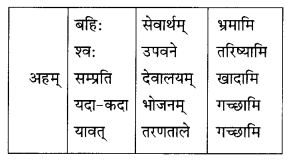
उत्तराणि:
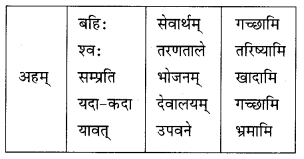
प्रश्न 2.
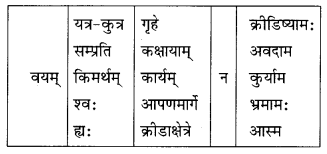
उत्तराणि:
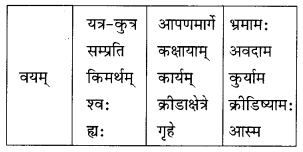
प्रश्न 3.
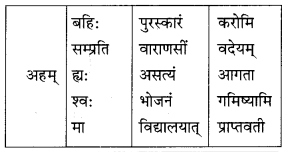
उत्तराणि:
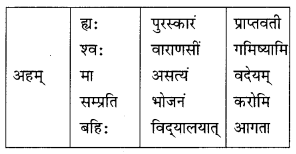
प्रश्न 4.
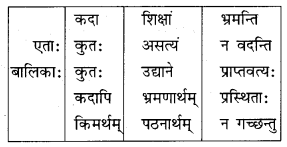
उत्तराणि:
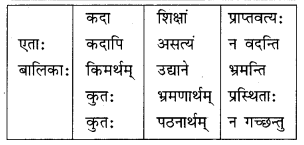
प्रश्न 5.
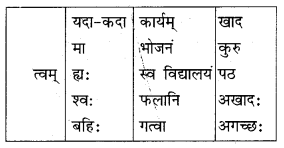
उत्तराणि:

